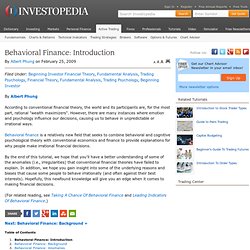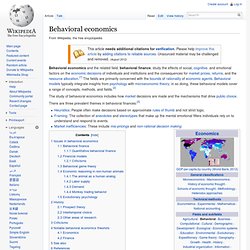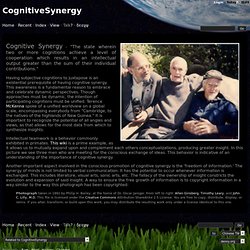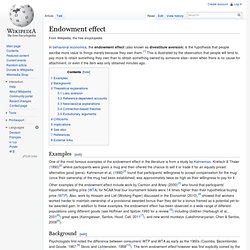

Choice theory. Choice theory may refer to:

Behavioural Economics - A Crash Course (Joe Pomykala) Behavioural economics. Behavioural Finance. Behavioural Dynamics Institute. Behavioral Finance: Introduction. By Albert Phung According to conventional financial theory, the world and its participants are, for the most part, rational "wealth maximizers".

However, there are many instances where emotion and psychology influence our decisions, causing us to behave in unpredictable or irrational ways. Behavioral finance is a relatively new field that seeks to combine behavioral and cognitive psychological theory with conventional economics and finance to provide explanations for why people make irrational financial decisions. Category:Organizational psychology. Behavioral economics. There are three prevalent themes in behavioral finances:[3] Issues in behavioral economics[edit] Behavioral finance[edit] The central issue in behavioral finance is explaining why market participants make systematic errors contrary to assumption of rational market participants.[1] Such errors affect prices and returns, creating market inefficiencies.

Dan Ariely. Daniel Kahneman: L'énigme de l'expérience et de la mémoire. Dan Ariely: What makes us feel good about our work? Barry Schwartz on the paradox of choice. Roles & Functions... Dimensions of Value. CognitiveInformaticsCognitiveSynergyPaper_v1 - CognitiveSynergy.pdf. Wiki : CognitiveSynergy. Cognitive Synergy - "The state wherein two or more cognitions achieve a level of cooperation which results in an intellectual output greater than the sum of their individual contributions.

" Having subjective cognitions to juxtapose is an existential prerequisite of having cognitive synergy. This awareness is a fundamental reason to embrace and celebrate dynamic perspectives. Though approaches must be dynamic, the intention of participating cognitions must be unified. Terence McKenna spoke of a unified worldview on a global scale, encompassing everybody from "Cambridge, to the natives of the highlands of New Guinea. " It is important to recognize the potential of all angles and views, as that allows for the most data from which to synthesize insights. Séquence processus psychologiques dans le jeu. A Theory of Fun for Game Design. Resonate_graphic_5.jpg (Image JPEG, 1350x1350 pixels) - Redimensionnée (59%) Community Feedback Shapes User Behavior. Tom Chatfield: 7 ways games reward the brain.
Octalysis: Complete Gamification Framework - Yu-kai Chou. (This is the Gamification Framework that I am most known for.

Within a year, it was translated into 9 different languages and became classic teaching literature in the gamification space in the US, Europe, Australia and South America.) Octalysis: Complete Gamification Framework Gamification is design that places the most emphasis on human motivation in the process. In essence, it is Human-Focused Design (as opposed to “function-focused design”). Most processes design around function and efficiency – they try to get the job done as quickly as possible. The 8 Core Drives of Gamification (#7): Unpredictability & Curiosity.
(Below is a snippet of Gamification Book: Actionable Gamification – Beyond Points, Badges, and Leaderboards.

If you like this blog post, you will LOVE the book.) Core Drive 7: Unpredictability & Curiosity Unpredictability & Curiosity is the seventh Core Drive in the Octalysis Gamification Framework and is the main force behind our infatuation with experiences that are uncertain and involve chance. As mentioned in earlier chapters, our intellectual consciousness is inherently lazy, and if tasks at hand do not demand immediate attention, the neocortex delegates the mental legwork to our subconscious mind, or “System 1” according to Economics Nobel Prize winner and psychologist Daniel Kahneman. The intellectual consciousness only wants to be disturbed when it is absolutely necessary, such as when a threat is present or when the brain encounters new information it hasn’t processed before. Coupled with this is our natural curiosity to explore. The 3rd Drive of Gamification: Empowerment of Creativity & Feedback. The Creative Core Drive in Gamification For a video walk-through, check out: Episode 10, Empowerment of Creativity & Feedback #1 and Episode 11, Empowerment of Creativity & Feedback #2 Empowerment of Creativity & Feedback is the Third Core Drive in Octalysis, and is one of the most powerful White Hat Gamification Drives that taps into our innate desire to want to create and build something meaningful to us.

Almost every day we indulge ourselves in a multitude of “what if” scenarios that make our mind spin in all sorts of directions trying to figure out new and creative ways to improve or build something. The beauty of this drive lies in its evergreen ability to continually engage us at all moments in our lives. Endowment effect. In behavioral economics, the endowment effect (also known as divestiture aversion) is the hypothesis that people ascribe more value to things merely because they own them.[1] This is illustrated by the observation that people will tend to pay more to retain something they own than to obtain something owned by someone else—even when there is no cause for attachment, or even if the item was only obtained minutes ago.

Examples[edit] One of the most famous examples of the endowment effect in the literature is from a study by Kahneman, Knetsch & Thaler (1990)[2] where participants were given a mug and then offered the chance to sell it or trade it for an equally priced alternative good (pens). Kahneman et al. (1990)[2] found that participants' willingness to accept compensation for the mug (once their ownership of the mug had been established) was approximately twice as high as their willingness to pay for it. Background[edit] Theoretical explanations[edit] The 8 Core Drives of Gamification (#6): Scarcity & Impatience. The 8 Core Drives of Gamification (#5): Social Pressure & Envy. For a video walk-through, check out: Episode 14, Social Influence & Relatedness+ Social Influence and Relatedness is the fifth core drive within my Gamification Framework Octalysis, which is related to activities inspired by what other people think, do, or say.

This Core Drive is the engine behind themes like mentorship, competition, envy, group quests, social treasures and companionship.+ This Core Drive also includes the “Relatedness” part, which deals with things like attachment to emotional associations and the feeling of nostalgia. The 8 Core Drives of Gamification (#4): Ownership and Possession. The 4th Core Drive of Gamification Ownership and possession, the fourth core drive in my Gamification Framework Octalysis , is based on the principle that because you own something, you want to take care of it and improve it. In addition, you will also want to possess more of it. Ownership and possession is position to the far left of Octalysis, and therefore represents the core drive which exhibits the strongest influence of Left Brain or analytical thinking. Here, decisions are based on more logical, calculating thought and the desire for possession as the primary motivating factors.
Psychology of rewards in web design. Categorized in: rewards, fixed rewards, variable rewards, reward schedules, contingencies There are two fundamental types of reward schedules which fundamentally change how rewards are experienced: fixed- and variable reward schedules.

Fixed rewards Fixed rewards are given out at a set time, amount, and type and are opposed to variable rewards, which feel more like random rewards. Delaying gratification is about worldview as much as willpower. Willpower alone doesn’t explain why some children forgo a marshmallow in hand for the prospect of getting two gooey treats later. Kids’ beliefs about the reliability of the people around them, such as the trustworthiness of an experimenter, can dramatically shape their willingness to wait for a sweeter payoff, a new study finds. Does Gamification work in a Knowledge Management environment? I spoke last week on the topic of gamifcation with Andrzej Marczewski (@daverage) and Stephen Dale (@stephendale).
Both have more than a passing interest in this topic: Andrzej is currently ranked the #1 ‘Gamification Guru’ (in a US online poll) who focuses on inter alia User Types, who blogs and publishes the Gamification News;Steve who has a long and distinguished career in Knowledge & Information (and who has chaired Online for a number of years) is interested in how behaviours are influenced by gamification and recently ran a well received workshop for NetIKx ‘#Gamification strategies for incentivising knowledge sharing and engagement: Risk aversion (psychology) The Video Game Engine in Your Head. For years now, physicists and engineers have been building computer simulations of physics in order to understand the behavior of objects in the world. Want to see if a bridge would be stable during an earthquake? Enter it into the simulation, apply earthquake dynamics, and see what happens.
Gamification, It’s About More than Badges: The Power of Engagement Through Quests. A quest is a traditional game mechanic that has proven extremely popular. Take, for example, World of Warcraft, a game built around quests with more then 11 million subscribers. By nature, gamification draws tactics from traditional and social gaming mechanics. Social dilemma. Contagion of Cooperation in Static and Fluid Social Networks. Gamers_Brain.png (Image PNG, 900x1200 pixels) Social psychology. The Moral Molecule. Comparison of technical filter mechanisms and defense mechanisms of the human mind. Looking for new paradigms in artificial intelligence, we are investigating functionalities of the human thinking process to manipulate information and filter perceptions. In this paper we introduce defense mechanisms of the human mind to be applied in artificial intelligence.
Thinking Traps. How wealth breeds narcissism. Call it the asshole effect. Moral hazard. In economic theory, a moral hazard is a situation where a party will have a tendency to take risks because the costs that could result will not be felt by the party taking the risk. In other words, it is a tendency to be more willing to take a risk, knowing that the potential costs or burdens of taking such risk will be borne, in whole or in part, by others. A moral hazard may occur where the actions of one party may change to the detriment of another after a financial transaction has taken place. Moral hazard arises because an individual or institution does not take the full consequences and responsibilities of its actions, and therefore has a tendency to act less carefully than it otherwise would, leaving another party to hold some responsibility for the consequences of those actions.
Games are good for learning. Hedgehog's dilemma. Both Arthur Schopenhauer and Sigmund Freud have used this situation to describe what they feel is the state of individual in relation to others in society. The hedgehog's dilemma suggests that despite goodwill, human intimacy cannot occur without substantial mutual harm, and what results is cautious behavior and weak relationships. Coopération-réciprocité-pardon. Un article de Wikipédia, l'encyclopédie libre. La stratégie coopération-réciprocité-pardon, plus connue sous le sigle CRP (traduite de Tit-for-Tat (TFT) en américain) ou « Win-Win » qui se résume mieux par « donnant-donnant » que la traduction littérale « gagnant-gagnant », a d’abord été formalisée par le biomathématicien, psychologue et philosophe Anatol Rapoport[1].
Reciprocity (cultural anthropology) In cultural anthropology, reciprocity refers to the non-market exchange of goods or labour ranging from direct barter (immediate exchange) to forms of gift exchange where a return is eventually expected (delayed exchange) as in the exchange of birthday gifts. It is thus distinct from the true gift, where no return is expected.[1] Reciprocity is said to be the basis of most non-market exchange.
David Graeber argues, "as currently used, 'reciprocity' can mean almost anything. Norm of reciprocity. Positive and negative[edit] Two key elements of the norm of reciprocity are positive and negative aspects to the term. Inequity aversion. Inequity aversion (IA) is the preference for fairness and resistance to incidental inequalities.[1] The social sciences that study inequity aversion include sociology, economics, psychology, anthropology, and ethology. Human studies[edit] The 8 Core Drives of Gamification (#8): Loss & Avoidance. Loss aversion. Ambiguity aversion.